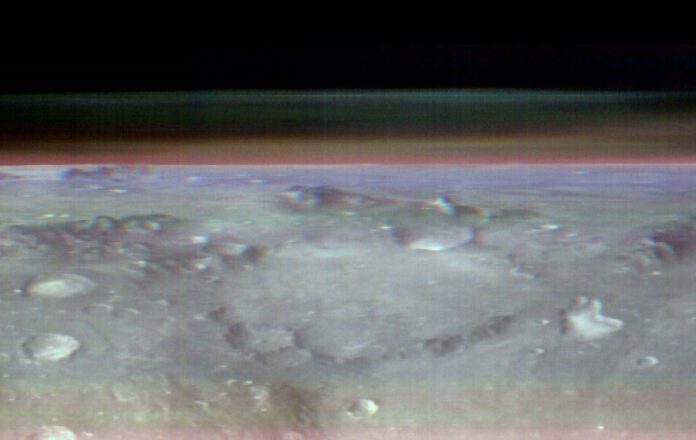
What the Martian vista would look like from an Orbiter’s lens
Astronauts frequently express great astonishment when they glimpse at the curvature of Earth from the International Space Station. Thanks to NASA’s 2001 Mars Odyssey Orbiter, we can now have a similar perspective around the planet Mars. “This would be the view astronauts would have if they were in orbit around Mars,” says Jonathan Hill of NASA. “So far, no Mars spacecraft has ever seen the landscapes in this manner,” adds Hill.
The incredible new image of the Martian Horizon
The breathtaking new image of the Martian horizon you see below was captured by the NASA’s 2001 Mars Odyssey Orbiter with the help of the onboard THEMIS infrared camera. The spacecraft was able to create these pictures in May from a height of about 400 kilometers. Coincidentally, this altitude is the same as the International Space Station’s orbit above Earth.
The spacecraft produced a series of panoramic images that showcase Mars’s rolling landscapes underneath the thin layers of dust and clouds. If you stitch together these ten images, not only will you have a completely new and impressive perspective of Mars, but you will also help scientists understand more about the atmosphere of the Red Planet.
Martian Atmosphere
With this mission, the researchers hoped to gain a clearer understanding of Martian atmosphere. The information gathered about the behavior of the layers of water ice clouds and Mars atmospheric dust was critical for scientists to enrich their models of the Martian atmosphere. “I compare it to looking at a cross-section of the atmosphere,” explains Jeffrey Plaut, Odyssey’s project scientist. “There are many details you can’t see from above, which is the usual way THEMIS carries out these measurements,” he adds.
Three months of repositioning and calibrating
Capturing this photo was indeed a hefty challenge. NASA engineers (who manage the mission) and Lockheed Martin Space (who built the Mars Odyssey and oversee daily operations) spent three months adjusting the orbiter’s position to alter the camera’s angle. Because THEMIS cannot rotate, the team had to maneuver the entire spacecraft. In doing so, they rotated the orbiter almost 90 degrees, ensuring the sun still shone on the solar panels, but not on sensitive equipment that could overheat. The easiest way to achieve this was to point the orbiter’s antenna away from Earth. As a result, they were unable to communicate with Odyssey for several hours until the procedure was completed.
Phobos
All the hard work did pay off, delivering a truly breathtaking image of the Martian horizon. In addition to capturing mars, they also took photographs of Mars’s small moon, Phobos. This marks the seventh occasion in the past 22 years the orbiter has turned its THEMIS lens towards the moon to measure temperature differences across its surface. “We got a different perspective and lighting conditions of Phobos than usual,” says Hill. “That makes it a unique part of our data collection about Phobos.”
The new photographs provide critical insights into the constitution and appearance of Phobos. Scientists continue to investigate this little moon, hoping that their findings could help solve a longstanding debate. Some believe Phobos, with a width of about 25 kilometers, is a captured asteroid, while others argue it is an ancient piece of Mars tossed off its surface due to an impact. Further research is required to provide clarity on this matter.
All in all, the stunning photo of the Martian horizon presents the planet from an entirely new angle, offering essential new insights. Furthermore, researchers plan to take similar photos of Mars using Mars Odyssey in the future, aiming to map out the Red Planet’s atmosphere across different seasons. Who knows what revealing details about this mysterious planet this could uncover?











